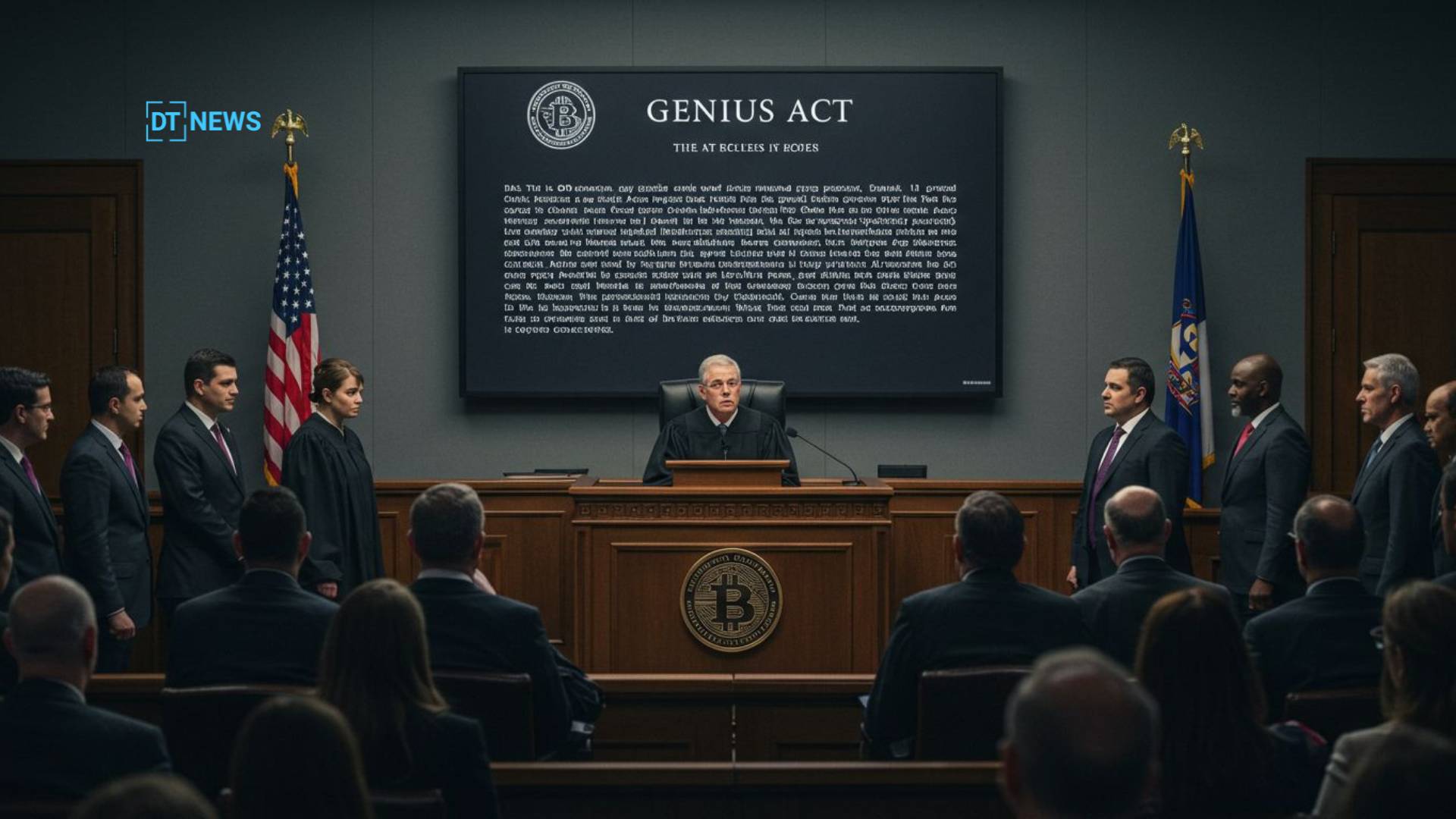According to latest reports, President Trump just signed the GENIUS Act into law. The “Guiding and Establishing National Innovation for U.S. Stablecoins Act” is the first federally sanctioned framework for payment stablecoins in the country.
- From Political Gridlock to Presidential Signature
- What the Law Actually Does
- USDT, USDC and DAI Under the Microscope
- SEC and CFTC Get Sidelined For Now
- US vs Europe: The Regulatory Arms Race
- Stealth CBDC or Blockade Against One?
- FAQs
- What is the GENIUS Act?
- How does the GENIUS Act impact stablecoin issuers?
- Is USDT or DAI banned under the GENIUS Act?
- Does the GENIUS Act stop the SEC from regulating stablecoins?
- Glossary
The passage of this bill, backed by a rare bipartisan coalition, offers the long‑awaited clarity for a segment of crypto that has thrived in legal ambiguity. Supporters cheered the move as the foundation for stablecoin regulation that could transform digital dollars into mainstream payments infrastructure.
However, beneath the celebration lies uncertainty over who wins, who adapts, and who risks being left behind.
From Political Gridlock to Presidential Signature
The passage of the GENIUS Act stablecoin regulation wasn’t an easy feat. It faced opposition from conservative Republicans and skeptical Democrats. According to Senator Bill Hagerty, the bill’s sponsor, bipartisan support only came after lawmakers added language from the Anti-CBDC Surveillance State Act to a national defense bill; essentially turning it into a compromise package.
“The GENIUS Act gives stablecoins a home in America,” Hagerty told CNBC. “We’re creating a regulatory regime that promotes innovation without sacrificing safety.”

What the Law Actually Does
For the first time ever, stablecoin issuers in the U.S. have to follow national rules. Companies will have to maintain full 1:1 cash or Treasury-backed reserves, undergo monthly third-party audits and submit their financials to regulators. The OCC and Fed will be in charge.
A Stablecoin Certification Review Committee, with reps from the Treasury, Fed and FDIC, will review state-level stablecoin programs. Smaller issuers (those with under $10 billion in circulation) can opt to be state-chartered, as long as the state framework is federally approved.
The law protects consumers more, but also imposes a 2-year moratorium on new algorithmic stablecoins. Many see this as a response to the TerraUSD collapse in 2022. The requirement to maintain “unbreakable” reserves and not reuse or lend them is a direct counter to what happened to Terra.
USDT, USDC and DAI Under the Microscope
For market leaders like USDT, the GENIUS Act is a big challenge. Tether’s reserve transparency has been an issue for years and the law’s monthly third-party audits will require a complete operational overhaul.
Tether has said they will comply with US regulations in the past, but this will test that in ways that haven’t been seen before.
USDC seems to be in better shape. Circle has always been regulatory aligned and their reserves are mostly cash and short-term US Treasuries. But they still have to meet the new CEO and CFO certified reserve disclosures.
DAI (DAI), issued by the decentralized MakerDAO, poses the toughest regulatory issue. Its crypto-collateralized, DAO-governed structure doesn’t fit into the legal definitions of an issuer.
“Who signs the audits for a smart contract?” asked Neeraj Agrawal, Communications Director at Coin Center. “The law sidesteps this entirely.”
SEC and CFTC Get Sidelined For Now
One of the most interesting things about the GENIUS Act is that it clearly defines payment stablecoins as neither securities nor commodities. This means the SEC and CFTC can’t assert jurisdiction over compliant stablecoin issuers.
According to the bill, the Treasury Department will still have authority over non-payment stablecoins alongside the SEC and CFTC, but this is a direct rebuke of what many in the industry call “regulation by enforcement”. For many crypto companies, this means fewer lawsuits and more clarity; at least in theory.
US vs Europe: The Regulatory Arms Race
The GENIUS Act stablecoin regulation puts the US in contrast with Europe’s Markets in Crypto-Assets (MiCA) framework. While MiCA provides a single license usable across all 27 EU member states, the US has a hybrid model with both federal and state options.
Critics say this introduces friction. Proponents say it allows for more local innovation and public-private collaboration. Whatever the outcome, both regions are now in a race to define the next era of digital finance.

Stealth CBDC or Blockade Against One?
The GENIUS Act hasn’t ended the debate around Central Bank Digital Currencies (CBDCs). The bill includes provisions from the Anti-CBDC Surveillance State Act which bars the Federal Reserve from offering direct-to-consumer digital currency accounts.
Supporters see this as a privacy safeguard.
“We don’t need a digital dollar when the private sector can innovate securely,” said Senator Cynthia Lummis
But critics call it a “stealth CBDC” itself, giving government regulators the power to freeze or burn assets; an authority that will likely be challenged in court in the coming months. Already, legal scholars are warning of Fourth Amendment issues.
Conclusion
Based on the latest research, the GENIUS Act has changed the scope of stablecoin regulation. While regulators have given the industry clarity and structure, implementation challenges and legal complexities remain. How state regulators interact with the federal committee, how decentralized projects like DAI comply, and how enforcement plays out in court are all unknowns.
Most in the industry agree the GENIUS Act is a great feat, but whether it will lead to more adoption or more fragmentation is still to be seen.
Read more about the GENIUS Act.
Summary
The GENIUS Act stablecoin regulation, now signed into law by President Trump, sets the first national rules for payment stablecoins in the U.S. It requires 1:1 cash or Treasury reserves, monthly audits and bans new algorithmic stablecoins for two years. It redefines regulatory roles, removing SEC and CFTC oversight from this crypto segment.
FAQs
What is the GENIUS Act?
The GENIUS Act, short for “Guiding and Establishing National Innovation for U.S. Stablecoins,” is a federal law establishing a regulatory framework for payment stablecoins in the United States.
How does the GENIUS Act impact stablecoin issuers?
Issuers must have 1:1 cash or Treasury-backed reserves, monthly audits and work under federal or approved state charters. Algorithmic coins are frozen for two years.
Is USDT or DAI banned under the GENIUS Act?
Not banned, but they face big operational challenges. Tether must restructure its reserves, and DAI’s decentralized governance doesn’t align with the Act’s issuer requirements.
Does the GENIUS Act stop the SEC from regulating stablecoins?
Yes, it explicitly defines payment stablecoins as outside the SEC and CFTC’s jurisdiction. Oversight falls to the Fed, OCC and Treasury instead.
Glossary
Stablecoin – digital asset pegged to the value of a fiat currency; like the US dollar.
Algorithmic Stablecoin – stablecoin backed by crypto or smart contracts; not fiat reserves.
OCC (Office of the Comptroller of the Currency) – US regulator that oversees national banks and now stablecoin issuers.
CBDC (Central Bank Digital Currency) – digital version of a country’s national currency issued by its central bank.
MiCA – Markets in Crypto-Assets regulation; the EU’s digital asset framework.
DAO (Decentralized Autonomous Organization) – A blockchain-based group governed by smart contracts; not people.



















































































































